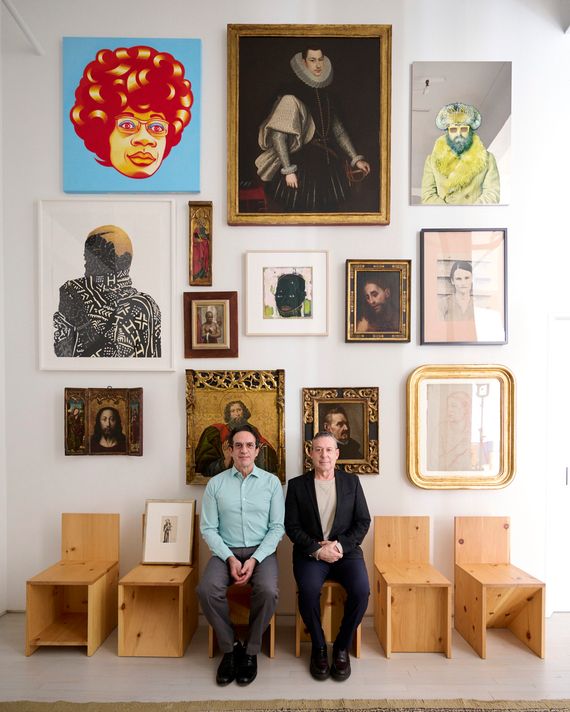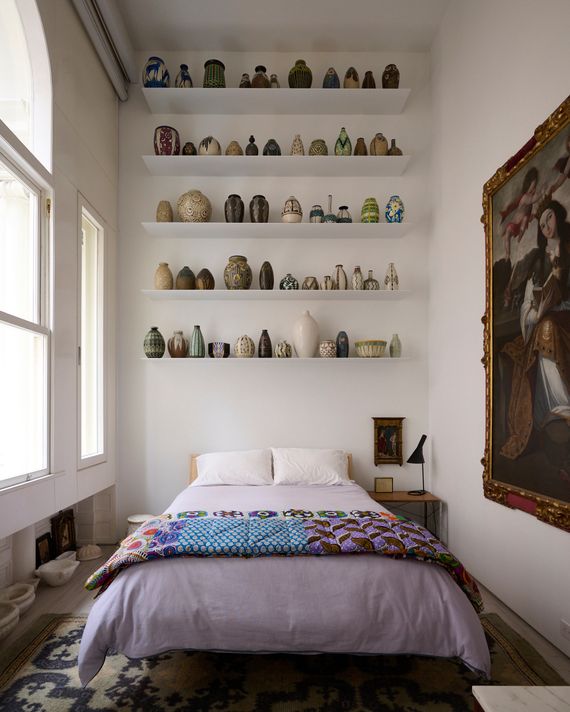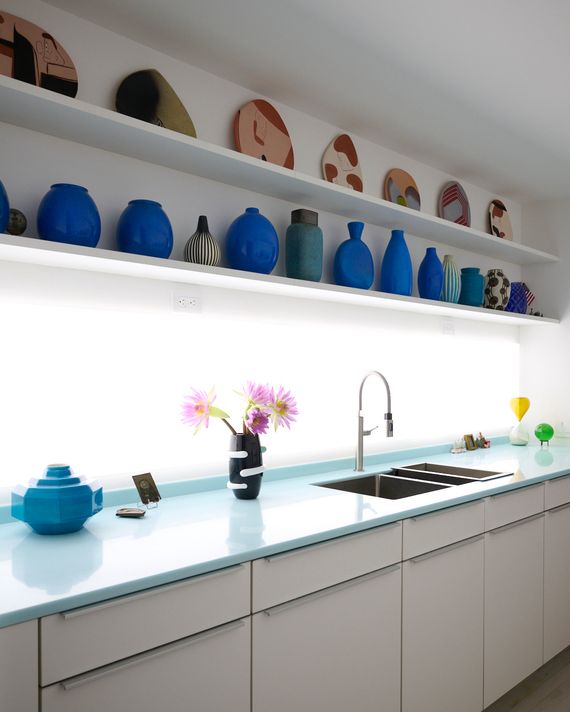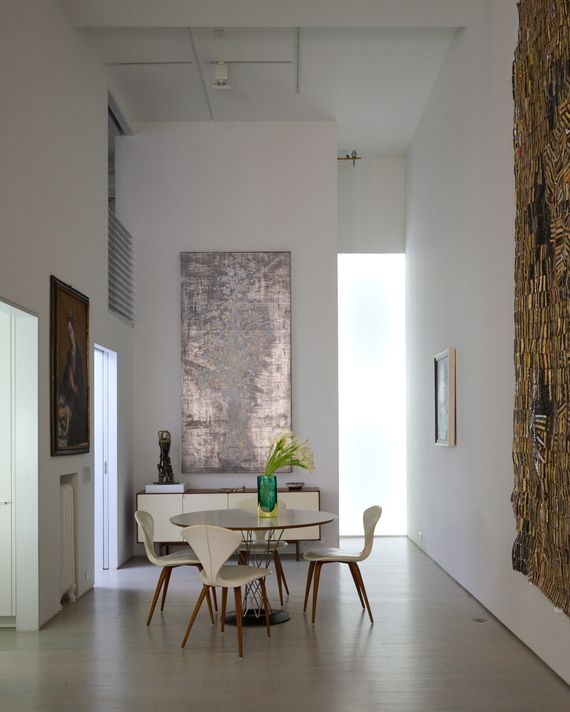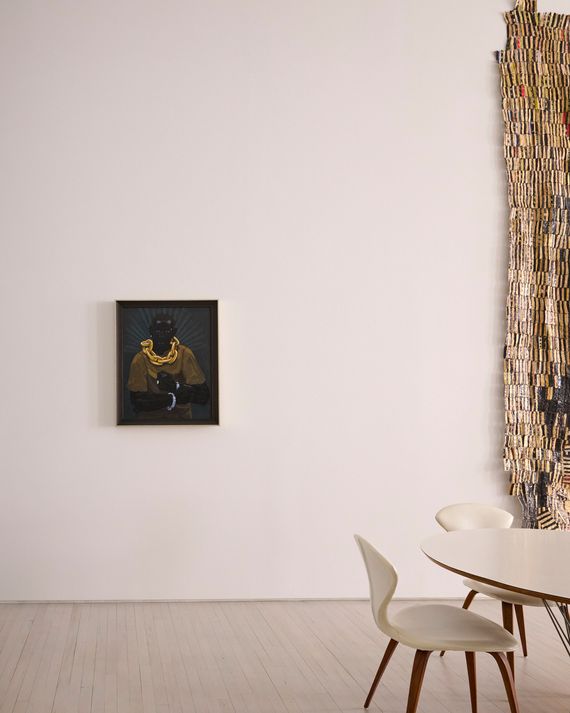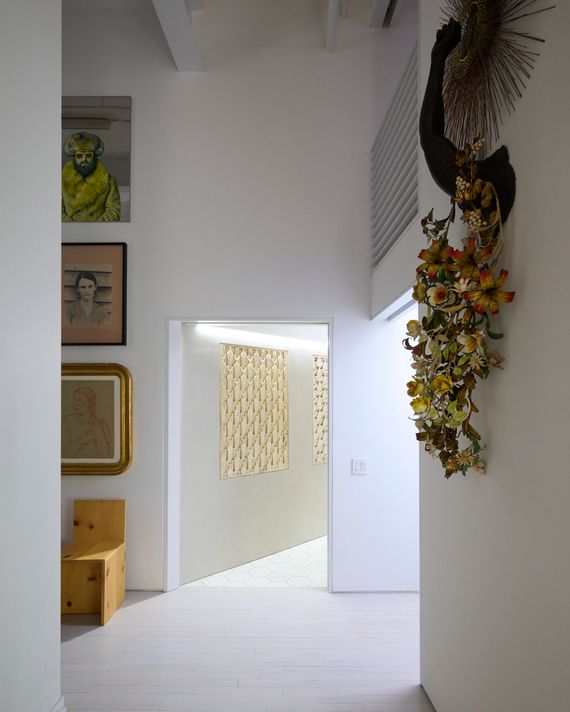An Apartment for Jack Shainman and Carlos Vega’s Art

The Living Room: “The Donald Judd furniture was something I always wanted,” Jack Shainman says. Emanoel Araújo’s polychrome wood sculpture hangs on the back wall; El Anatsui’s Obscured Narrative is on the right wall; a 16th-century panel and chest is on the left.
Photo: Jason Schmidt
It was dreary. I mean really dreary,” gallerist Jack Shainman says of the loft, which occupies part of what was once a ballroom in an 1872 building near Madison Square that he and his artist-husband Carlos Vega bought a decade ago. The apartment hadn’t been inhabited for years and was filled with unclaimed furniture scattered around the dark musty space that retained the trimmings of ’80s living: gold-painted tin ceilings and pipes, ruddy natural brick walls, and, in one corner, a narrow spiral staircase that led to the primary bedroom with its uninviting brown hot tub.
“It was very unattractive,” Vega agrees, “but immediately the scale-“-2,057 square feet and 16-foot ceilings–“was the most exciting thing.” They wanted space, both for themselves and for their rotating art collection.
At the time of my visit, they are living with Emanoel Araújo’s Relevo, a monumental wall sculpture of polychrome wood, and, on another wall, El Anatsui’s Obscured Narrative, a tapestry composed of aluminum and copper wire that hangs opposite a 16th–century work, The Virgin and Child With Saint Anne, Saint John the Baptist, and Saint Sebastian. There’s Donald Judd furniture in the living room along with Arturo Hererra’s felt One Time (Orange) placed between the windows, looking as if it had blown in on a breeze and just -happened to attach on that spot.
Renaissance religious and royal paintings face off with the powerful beauty of portraits by Kerry James Marshall, Toyin Ojih Odutola, Barkley L. Hendricks, Michelangelo Pistoletto, and Lynette Yiadom-Boakye. The juxtapositions add to the impact of the collection that changes according to what Shainman and Vega decide to exhibit at any given time.
Collecting started early for Shainman, whose father was a professor at Williams College. He’d visit the Clark Art Institute where, he says, “as a kid, I especially liked the old paintings but mostly the famous Bouguereau, Nymphs and Satyr.” He adds, laughing, “It was titillating as a child. It was probably like porn, almost.” He started buying photographs from students at age 10 for $20 or $30. “I still have those. Some of them still look really good.”
Shainman opened a gallery in 1984 in Washington, D.C., with his then-partner, Claude Simard. An early show featured the work of a self-taught postal worker, John Robinson. “I found these paintings,” he says. “I mean we always love bringing something into the art world that wasn’t considered.” Nine years later, he sought out Kerry James Marshall and gave him his first exhibition in New York City, where Shainman had moved his gallery. In 2014, Shainman opened a 30,000-square-foot exhibition space, the School, in a former Kinderhook high school near his 235-acre farm upstate in Stuyvesant. This fall, he will open a new space in the landmarked, Tribeca-adjacent Clock Tower Building. (His Chelsea gallery will remain open.)
Vega grew up in Spain and North Africa before moving to the U.S. to attend the Art Institute of Chicago. He and Shainman have been together since 1995, often making a home in spaces tighter than this loft. “For years,” Vega says, “we lived in a very little apartment; 11 years at Eighth Avenue and 21st Street.”
“Although,” Shainman points out, “we actually had big art in there. It made it look bigger.”
The Entrance Hall: Vega, left, and Shainman seated on Judd chairs beneath paintings of different eras, including works by Gomez Bueno, Rodrigo de Villandrando, Michelangelo Pistoletto, Toyin Ojih Odutola, and Kerry James Marshall.
Photo: Jason Schmidt
The Guest Room: The shelves, and 16-foot ceilings, create space for a collection of Charles Catteau pottery.
Photo: Jason Schmidt
The Kitchen: The renovation included moving and enclosing the kitchen. Charles Catteau and Barry McGee ceramics are on the shelves.
Photo: Jason Schmidt
The Dining Area “I have had that Noguchi table since the early days of Washington D.C., 1985. The chairs have changed a few times because they just don’t last,” Shainman says the area they use for meetings and meals. Carlos Vega’s Ivory Tower, 2012, made with stamps and oil paint on lead is on the back wall behind the table.
Photo: Jason Schmidt
Dining Area Wall: Kerry James Marshall’s Ecce Homo, 2008-2014, acrylic on PVC panel, hangs opposite the dining table.
Photo: Jason Schmidt
View into Powder Room: Nick Cave’s Arm Piece, 2018, made of cast bronze, and vintage sunburst and tole flowers, hangs on the wall to the right of the kitchen door, at the far end of the entrance hall. Two 19th-century marble-panel rain water drains from India can be seen on the wall inside the powder room.
Photo: Jason Schmidt
See All
Source link

